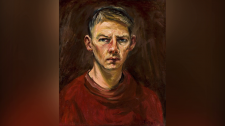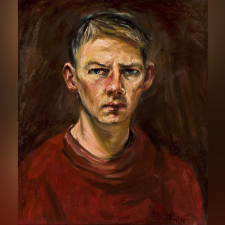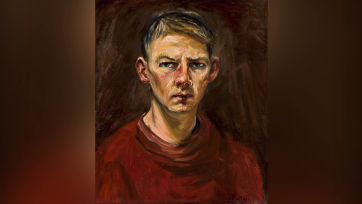An open house, recollections of my early life: extracts from the reminiscences of David Boyd.
The mental disturbances and anguish of Dostoyevsky's characters, in particular, The Brothers Karamazov, had a profound effect on seventeen-year-old Arthur. He would take the book to bed and read on through the night. The Idiot, Dostoyevsky's tale of a gentle, but tormented epileptic also troubled Arthur. After a night of reading that followed a full day's work, the quivering of his nerves frightened him into the belief that Merric's inherited affliction lay dormant within him, and that any day now, he might succumb to an attack.
Although he continued to paint the gentler moods of the countryside, a disturbing element now appeared in Arthur's portraiture. His subjects no longer looked quietly and untroubled from the canvas. Like Dostoyevsky, he now attempted through his portraits to penetrate the less accessible areas of human character and psychology. Inevitably, some of the portraits were not flattering.
"Now, sit on that chair over there under the small window. Better still, go beside the fireplace. Yeah, yeah, that'll do. No, no, that's no good. Go back to the window. Right. Now, turn your head a bit to the left ... I said the left, not the right. Can't you tell the left from the right? All right, then. I meant my left. So the left is your right."
After this setting into position routine, and after he had propped a canvas on the easel, the serious business of capturing my likeness began. The only pleasure in sitting for a portrait is that your best features, which you consider most evident, will be captures, and thereby justify the discomfort of holding an unnatural pose for a protracted period. But, at the age of fourteen, I did not know that portrait painters superimposed facets of themselves on a likeness of their subject. Although, supposedly, studying the features of another, they are in fact, involuntarily holding a mirror to their own mood.
It happened, during this sitting, that in order to relieve the boredom, I had inwardly cast myself in a heroic mould. Strutting the poop deck with cutlass in hand, I was about to slaughter Basil Rathbone, when Arthur's sharp command, "Wipe that ridiculous, sloppy grin off your face! You're not posing for a silly photograph." Rescued my celluloid villain from a theatrically suitable end. Smiling sheepishly, I complained that my foot had pins and needles, and that I would like a rest.
"Pins and needles won't hurt you. You can have a rest in a minute, but not just yet, just don't move. That's right. Keep looking up at the ceiling like that, keep your head on its side ... Not the other side, the left side." The inspired gleam in my brother's eyes indicated that he was about to unravel the mysteries of my inner being. Further protest would be a waste of time, so I stared fixedly at a damp patch on the ceiling.
"Stop licking your lips. You look as though you're eating something." Arthur shook a pigment loaded brush from behind the easel. "And stop fidgeting. How in the hell do you think I can paint your portrait if you make stupid faces like that? And for God's sake, don't look down again from the ceiling."
The expression of intense concentration returned to Arthur's face. Between careful strokes and dabs with the brush, he frowned and squinted at me around the side of the easel. Like most people, I have an urge to return the gaze of another, and before long, I was involuntarily squinting and frowning at him. "Don't look at me, David. Keep your eyes on the ceiling."
"But, I'm sick of looking at the ceiling," I replied. "Can't you paint me looking at you? It'll give me something to do." "No," said Arthur, "Certainly not. I don't like being looked at when I'm painting." "But Max looks at you when you paint him." Arthur replied, "That's why I only do his profile nowadays." "But, he still seems to be looking at you."
"I can't stop him looking out of the corners of his eyes, can I? Anyway, he keeps his eyes half closed, and at least he knows how to keep still, so shut up, just shut up! And please, Davie boy, keep still, just for a minute longer, and I'll let you go. I'm on your left eye now."
Thus, the sitting progressed, until, with a grunt of satisfaction, Arthur tilted back his head to study the portrait. "It's not too bad," he said, "It's not quite what I wanted. You can have a look at it, if you like." The axiom that the reflection of ourselves we study in a looking glass is not the one of solid bone and flesh seen by others was forcefully illustrated when I looked for the first time at the portrait. The discovery that my brother had failed to notice my likeness to various dashing film stars dealt a crushing blow to the image I had of my adolescent self. This was not the face of a handsome buccaneer who would soon have Olivia de Havilland swooning at his feet, or for whom a thousand pretty maidens were destined to pine away their lives in unrequited love. With a sinking feeling, I looked instead upon the troubled face of a youth who would flinch from swatting a fly, much less administer the coup de grâce of Basil Rathbone on the quarterdeck.
Although Arthur seldom invited an opinion of his work, he accepted praise with a self-deprecating smile, and a nodding of the head. Quite early in his career, he had perfected the technique of remaining silent until an admirer had exhausted his or her store of superlatives. He would then announce, that in his own opinion, the picture was no good. His immediate family were used to this trick, but it was disconcerting for people who were expert critics, and even for those who, in fact, knew what they were talking about. But on this Sunday afternoon, it was Arthur who made the first comment.
"You are not easy to paint, Davie boy." The apologetic tone of his voice suggested that it was the depths of an unusually interesting personality rather than my restless behaviour that had made his task difficult. The remark also had the effect of restoring my self-esteem. The eyes, I now noticed, suggested that their possessor had hungered for something more spiritual than a piece of cake. Like a martyred saint, their upward gaze was fixed far above a damp patch on the ceiling. The mouth, however, told a different story. The voluptuous lips, arranged to suggest the ghost of a sensuous smile, seemed to have an appetite for something more than cake.
"Yes, Chook Chooks," I said, "It's a nice painting. You've made a nice job of my eyes, but the lips look a bit thick. Just like the ones in your picture of The Brothers Karamazov."









